会计专业英语资料
会计专业英语复习资料.doc
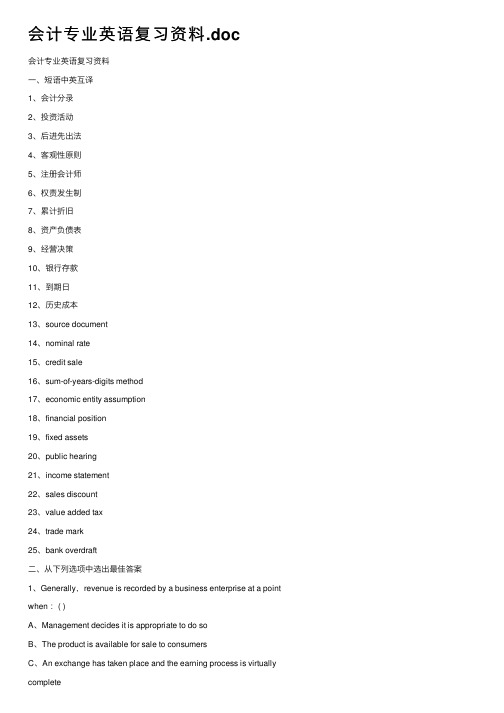
会计专业英语复习资料.doc会计专业英语复习资料⼀、短语中英互译1、会计分录2、投资活动3、后进先出法4、客观性原则5、注册会计师6、权责发⽣制7、累计折旧8、资产负债表9、经营决策10、银⾏存款11、到期⽇12、历史成本13、source document14、nominal rate15、credit sale16、sum-of-years-digits method17、economic entity assumption18、financial position19、fixed assets20、public hearing21、income statement22、sales discount23、value added tax24、trade mark25、bank overdraft⼆、从下列选项中选出最佳答案1、Generally,revenue is recorded by a business enterprise at a point when :( )A、Management decides it is appropriate to do soB、The product is available for sale to consumersC、An exchange has taken place and the earning process is virtually completeD、An order for merchandise has been received2、Why are certain costs capitalized when incurred and then depreciated or amortized over subsequent accounting periods?( )A、To reduce the income tax liabilityB、To aid management in making business decisionsC、To match the costs of production with revenue as earnedD、To adhere to the accounting concept of conservatism3、What accounting principle or concept justifies the use of accruals and deferrals?( )A、Going concernB、MaterialityC、ConsistencyD、Stable monetary unit4、An accrued expense can best be described as an amount ( )A、Paid and currently matched with revenueB、Paid and not currently matched with revenueC、Not paid and not currently matched with revenueD、Not paid and currently matched with revenue5、Continuation of a business enterprise in the absence of contrary evidence is an example of the principle or concept of ( )A、Business entityB、ConsistencyC、Going concernD、Substance over form6、In preparing a bank reconciliation,the amount of checks outstanding would be:( )A、added to the bank balance according to the bank statement.B、deducted from the bank balance according to the bank statement.C、added to the cash balance according to the depositor’s records.D、deducted from the cash balance according to the depositor’s records.7、Journal entries based on the bank reconciliation are required for:( )A、additions to the cash balance according to the depositor’s records.B、deductions from the cash balance according to the depositor’srecords.C、Both A and BD、Neither A nor B8、A petty cash fund is :( )A、used to pay relatively small amounts。
专业英语课件(会计专业)

A financial statement that shows the inflow and outflow of cash and cash equivalents over a period of time
The process of calculating and interpreting financial ratios to assess a company's performance, financial position, and liquidity
Understand and apply international accounting standards: Learners should gain a through understanding of international accounting standards and be able to apply them in practice
Enhance critical thinking and problem solving skills: Through the study of accounting professional English, learners should develop critical thinking and problem solving skills that are essential for success in the accounting field
The Learning Objectives of Accounting
Professional English
01
02
03
Develop language skills for effective communication: Learners should be able to communicate confidently and effectively in English, both orally and in writing, in accounting related contexts
会计的基本英语知识点汇总
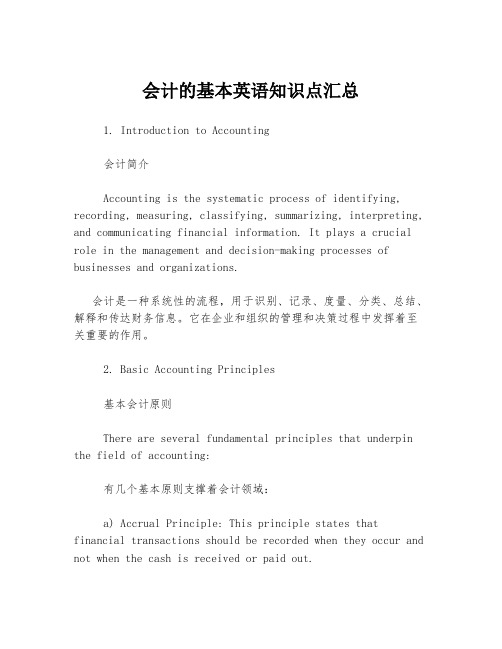
会计的基本英语知识点汇总1. Introduction to Accounting会计简介Accounting is the systematic process of identifying, recording, measuring, classifying, summarizing, interpreting, and communicating financial information. It plays a crucial role in the management and decision-making processes of businesses and organizations.会计是一种系统性的流程,用于识别、记录、度量、分类、总结、解释和传达财务信息。
它在企业和组织的管理和决策过程中发挥着至关重要的作用。
2. Basic Accounting Principles基本会计原则There are several fundamental principles that underpin the field of accounting:有几个基本原则支撑着会计领域:a) Accrual Principle: This principle states that financial transactions should be recorded when they occur and not when the cash is received or paid out.应计原则:该原则规定财务交易应在其发生时记录,而不是在现金收到或支付时记录。
b) Matching Principle: This principle states that expenses should be recognized in the same accounting period as the revenues they help generate.配比原则:该原则规定支出应在与其相关的收入产生的同一会计期间内确认。
会计笔记英语知识点归纳

会计笔记英语知识点归纳会计是一门与经济紧密相关的学科,对于学习和从事会计工作的人来说,掌握好会计笔记的英语知识点非常重要。
本文将归纳一些常见的会计笔记英语知识点,帮助读者更好地理解和运用这些概念。
1. Financial Statements(财务报表)Financial statements are crucial in accounting as they provide a comprehensive summary of a company's financial activities. The four main types of financial statements are: balance sheet, income statement, cash flow statement, and statement of changes in equity.财务报表在会计中非常重要,因为它们提供了一个公司财务活动的综合概述。
财务报表有四种主要类型:资产负债表、损益表、现金流量表和股东权益变动表。
2. Double-Entry Bookkeeping(复式记账法)Double-entry bookkeeping is a fundamental concept in accounting.It states that every financial transaction has equal and opposite effectson at least two accounts. This ensures that the accounting equation (assets = liabilities + equity) remains balanced.复式记账法是会计中的一个基本概念。
它指出每一笔财务交易对至少两个账户产生相等且相反的影响。
这样可以确保会计方程式(资产=负债+所有者权益)保持平衡。
会计专业英语知识点

会计专业英语知识点作为一门重要的商科专业,会计在各行各业中都扮演着重要的角色。
对于学习会计的学生来说,掌握好会计专业的英语知识点是非常必要的。
本文将介绍一些与会计专业相关的英语知识点,以帮助学生在学习和实践中更好地应用。
一、会计基础术语1. Assets(资产):在会计中,资产指的是公司拥有的具有现金价值的资源,包括现金、存货、房地产等。
2. Liabilities(负债):负债是指公司对外的债务或应付款项,在会计中包括借款、应付账款等。
3. Equity(所有者权益):也被称为净资产或股东权益,表示公司的所有者对于其资产净值的权益。
4. Revenue(收入):收入是指公司通过销售产品或提供服务而获得的资金流入。
5. Expenses(费用):费用是指公司为经营活动而发生的支出,包括租金、工资、税金等。
6. Balance Sheet(资产负债表):资产负债表是一份会计报表,以资产、负债和所有者权益的形式显示公司的财务状况。
二、会计报表1. Income Statement(利润表):利润表显示了公司在一定期间内的收入、费用和净利润。
2. Cash Flow Statement(现金流量表):现金流量表反映了公司在一定期间内现金收入、现金支出以及现金净增加额。
3. Statement of Retained Earnings(留存收益表):留存收益表展示了公司在一定期间内的净利润和分红情况。
4. Statement of Changes in Equity(权益变动表):权益变动表展示了公司在一段时间内所有者权益的变化情况,包括净利润、股东投资等。
三、审计和税务1. Audit(审计):审计是对公司财务报表和财务记录的全面审核和检查。
2. Taxation(税务):税务是指涉及支付税款和申报纳税义务的活动,包括个人所得税、企业所得税等。
3. Tax Return(纳税申报表):纳税申报表是个人或企业向税务机关报告收入和纳税情况的文件。
会计专业读的英语书
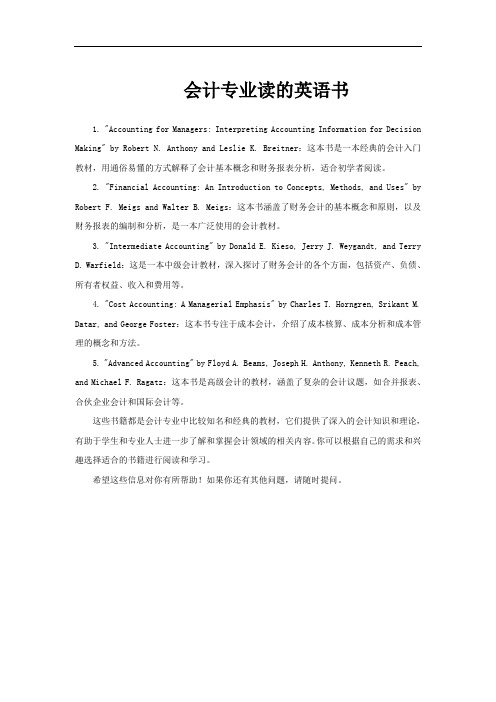
会计专业读的英语书1. "Accounting for Managers: Interpreting Accounting Information for Decision Making" by Robert N. Anthony and Leslie K. Breitner:这本书是一本经典的会计入门教材,用通俗易懂的方式解释了会计基本概念和财务报表分析,适合初学者阅读。
2. "Financial Accounting: An Introduction to Concepts, Methods, and Uses" by Robert F. Meigs and Walter B. Meigs:这本书涵盖了财务会计的基本概念和原则,以及财务报表的编制和分析,是一本广泛使用的会计教材。
3. "Intermediate Accounting" by Donald E. Kieso, Jerry J. Weygandt, and TerryD. Warfield:这是一本中级会计教材,深入探讨了财务会计的各个方面,包括资产、负债、所有者权益、收入和费用等。
4. "Cost Accounting: A Managerial Emphasis" by Charles T. Horngren, Srikant M. Datar, and George Foster:这本书专注于成本会计,介绍了成本核算、成本分析和成本管理的概念和方法。
5. "Advanced Accounting" by Floyd A. Beams, Joseph H. Anthony, Kenneth R. Peach, and Michael F. Ragatz:这本书是高级会计的教材,涵盖了复杂的会计议题,如合并报表、合伙企业会计和国际会计等。
会计专业英语汇总
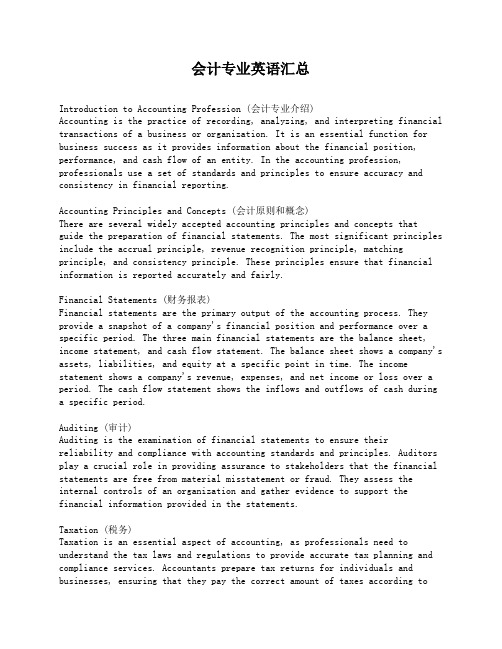
会计专业英语汇总Introduction to Accounting Profession (会计专业介绍)Accounting is the practice of recording, analyzing, and interpreting financial transactions of a business or organization. It is an essential function for business success as it provides information about the financial position, performance, and cash flow of an entity. In the accounting profession, professionals use a set of standards and principles to ensure accuracy and consistency in financial reporting.Accounting Principles and Concepts (会计原则和概念)There are several widely accepted accounting principles and concepts that guide the preparation of financial statements. The most significant principles include the accrual principle, revenue recognition principle, matching principle, and consistency principle. These principles ensure that financial information is reported accurately and fairly.Financial Statements (财务报表)Financial statements are the primary output of the accounting process. They provide a snapshot of a company's financial position and performance over a specific period. The three main financial statements are the balance sheet, income statement, and cash flow statement. The balance sheet shows a company's assets, liabilities, and equity at a specific point in time. The income statement shows a company's revenue, expenses, and net income or loss over a period. The cash flow statement shows the inflows and outflows of cash during a specific period.Auditing (审计)Auditing is the examination of financial statements to ensure theirreliability and compliance with accounting standards and principles. Auditors play a crucial role in providing assurance to stakeholders that the financial statements are free from material misstatement or fraud. They assess the internal controls of an organization and gather evidence to support the financial information provided in the statements.Taxation (税务)Taxation is an essential aspect of accounting, as professionals need to understand the tax laws and regulations to provide accurate tax planning and compliance services. Accountants prepare tax returns for individuals and businesses, ensuring that they pay the correct amount of taxes according tothe applicable laws.Cost Accounting (成本会计)Cost accounting focuses on the analysis and control of costs in a business. It involves determining the cost of producing goods or services and analyzing the profitability of different products or services. Cost accountants provide valuable information for decision-making, such as pricing strategies, budgeting, and cost reduction initiatives.Management Accounting (管理会计)Management accounting involves the use of financial information to support managerial decision-making. Management accountants provide reports and analysis to help managers make informed decisions about resource allocation, performance evaluation, and strategic planning. They may also be involved in budgeting, forecasting, and variance analysis.International Financial Reporting Standards (国际财务报告准则)International Financial Reporting Standards (IFRS) is a set of accounting standards developed by the International Accounting Standards Board (IASB). IFRS is widely adopted in many countries around the world, with the aim of promoting transparency and comparability of financial statements globally. Knowledge of IFRS is essential for accountants working in multinational organizations or those seeking international opportunities.Ethics in Accounting (会计伦理)Ethics play a crucial role in the accounting profession. Accountants are expected to maintain integrity, objectivity, and professional skepticism in their work. They must adhere to ethical codes and standards set by professional accounting bodies, such as the American Institute of Certified Public Accountants (AICPA) or the Association of Chartered Certified Accountants (ACCA).Conclusion (结论)Accounting is a dynamic and challenging profession that requires bothtechnical knowledge and ethical behavior. Professionals in the field play a critical role in helping businesses make informed financial decisions and ensuring compliance with accounting standards. The knowledge and skills gained through studying accounting and mastering accounting English are valuable assets that can open doors to a variety of career opportunities.。
会计专业基础英语
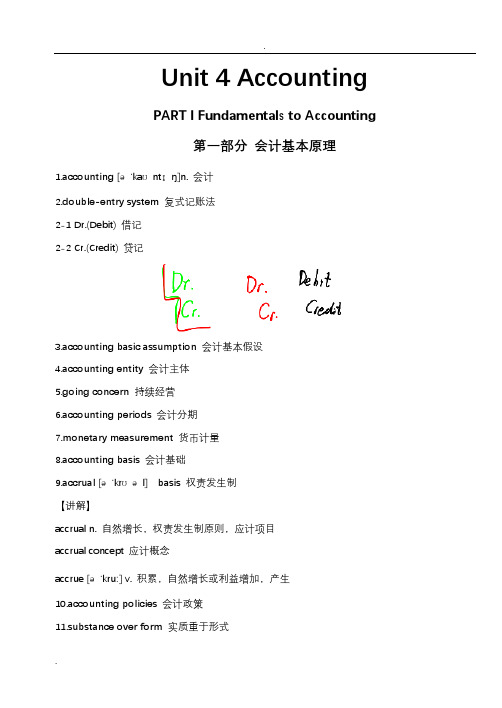
Unit 4 AccountingPART I Fundamentals to Accounting第一部分会计基本原理1.accounting [ə'kaʊntɪŋ]n. 会计2.double-entry system复式记账法2-1 Dr.(Debit) 借记2-2 Cr.(Credit) 贷记3.accounting basic assumption会计基本假设4.accounting entity会计主体5.going concern持续经营6.accounting periods会计分期7.monetary measurement货币计量8.accounting basis会计基础9.accrual [ə'krʊəl] basis权责发生制【讲解】accrual n. 自然增长,权责发生制原则,应计项目accrual concept 应计概念accrue [ə'kruː] v. 积累,自然增长或利益增加,产生10.accounting policies会计政策11.substance over form实质重于形式12.accounting elements会计要素13.recognition [rekəg'nɪʃ(ə)n] n. 确认13-1 initial recognition [rekəg'nɪʃ(ə)n] 初始确认【讲解】recognize ['rɛkəg'naɪz] v. 确认14.measurement ['meʒəm(ə)nt] n. 计量14-1 subsequent ['sʌbsɪkw(ə)nt] measurement 后续计量15.asset ['æset] n. 资产16.liability [laɪə'bɪlɪtɪ] n. 负债17.owners’ equity所有者权益18.shareholder’s equity股东权益19.expense [ɪk'spens; ek-] n. 费用20.profit ['prɒfɪt] n. 利润21.residual [rɪ'zɪdjʊəl] equity剩余权益22.residual claim剩余索取权23.capital ['kæpɪt(ə)l] n. 资本24.gains [ɡeinz] n. 利得25.loss [lɒs] n. 损失26.Retained earnings留存收益27.Share premium股本溢价28.historical cost历史成本【讲解】historical [hɪ'stɒrɪk(ə)l] adj. 历史的,历史上的historic [hɪ'stɒrɪk] adj. 有历史意义的,历史上著名的28-1 replacement [rɪ'pleɪsm(ə)nt] cost 重置成本29.Balance Sheet/Statement of Financial Position资产负债表29-1 Income Statement 利润表29-2 Cash Flow Statement 现金流量表29-3 Statement of changes in owners’equity (or shareholders’equity) 所有者权益(股东权益)变动表29-4 notes [nəʊts] n. 附注PART II Financial Assets*第二部分金融资产*30.financial assets金融资产e.g. A financial instrument is any contract that gives rise to a financial asset of one enterprise and a financial liability or equity instrument of another enterprise. 【讲解】give rise to 引起,导致31.cash on hand 库存现金32.bank deposits [dɪ'pɒzɪt] 银行存款33.A/R, account receivable应收账款34.notes receivable应收票据35.others receivable其他应收款项36.equity investment股权投资37.bond investment债券投资38.derivative financial instrument衍生金融工具39.active market活跃市场40.quotation [kwə(ʊ)'teɪʃ(ə)n]n. 报价41.financial assets at fair value through profit or loss以公允价值计量且其变动计入当期损益的金融资产41-1 those designated as at fair value through profit or loss 指定为以公允价值计量且其变动计入当期损益的金融资产41-2 financial assets held for trading 交易性金融资产42.financial liability金融负债43.transaction costs交易费用43-1 incremental external cost 新增的外部费用【讲解】incremental [ɪnkrə'məntl] adj. 增量的,增值的44.cash dividend declared but not distributed 已宣告但尚未发放的现金股利投资收益45.profit and loss arising from fair value changes公允价值变动损益46.Held-to-maturity investments持有至到期投资47.amortized cost摊余成本【讲解】amortized [ə'mɔ:taizd]adj. 分期偿还的,已摊销的48.effective interest rate实际利率49.loan [ləʊn] n. 贷款50.receivables [ri'si:vəblz] n. 应收账款51.available-for-sale financial assets可供出售金融资产52.impairment of financial assets金融资产减值52-1 impairment loss of financial assets 金融资产减值损失53.transfer of financial assets金融资产转移53-1 transfer of the financial asset in its entirety 金融资产整体转移53-2 transfer of a part of the financial asset 金融资产部分转移54.derecognition [diː'rekəg'nɪʃən] n. 终止确认,撤销承认54-1 derecognize [diː'rekəgnaɪz] v. 撤销承认e.g. An enterprise shall derecognize a financial liability (or part of it) only when the underlying present obligation (or part of it) is discharged/cancelled.【译】金融负债的现时义务全部或部分已经解除的,才能终止确认该金融负债或其一部分。
会计英文知识点
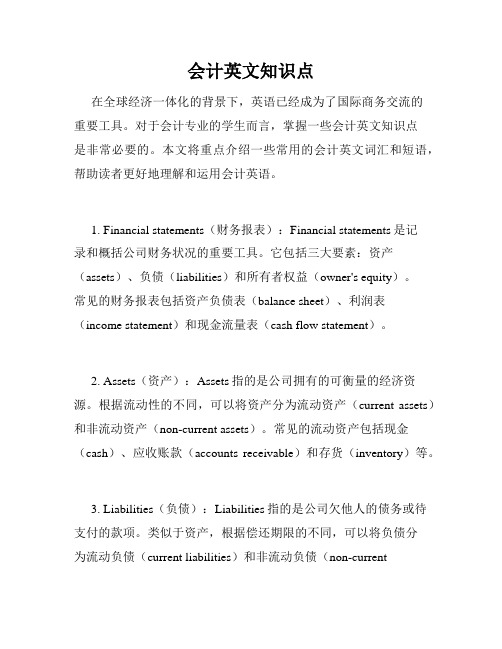
会计英文知识点在全球经济一体化的背景下,英语已经成为了国际商务交流的重要工具。
对于会计专业的学生而言,掌握一些会计英文知识点是非常必要的。
本文将重点介绍一些常用的会计英文词汇和短语,帮助读者更好地理解和运用会计英语。
1. Financial statements(财务报表):Financial statements是记录和概括公司财务状况的重要工具。
它包括三大要素:资产(assets)、负债(liabilities)和所有者权益(owner's equity)。
常见的财务报表包括资产负债表(balance sheet)、利润表(income statement)和现金流量表(cash flow statement)。
2. Assets(资产):Assets指的是公司拥有的可衡量的经济资源。
根据流动性的不同,可以将资产分为流动资产(current assets)和非流动资产(non-current assets)。
常见的流动资产包括现金(cash)、应收账款(accounts receivable)和存货(inventory)等。
3. Liabilities(负债):Liabilities指的是公司欠他人的债务或待支付的款项。
类似于资产,根据偿还期限的不同,可以将负债分为流动负债(current liabilities)和非流动负债(non-currentliabilities)。
常见的流动负债包括应付账款(accounts payable)和短期借款(short-term borrowings)等。
4. Owner's equity(所有者权益):Owner's equity指的是公司归属于所有者的净资产。
它由资本(capital)和利润(profit)构成。
如果资产超过负债,那么所有者权益为正数;如果负债超过资产,那么所有者权益为负数。
5. Depreciation(折旧):Depreciation指的是固定资产(fixed assets)在使用过程中价值的减少。
会计专业英语(五篇范例)

会计专业英语(五篇范例)第一篇:会计专业英语Accounting termsAccounting entity会计主体Accounting procedure会计核算Accounting process会计程序/过程Accounting practice会计核算Accounting element会计要素Accounting principle会计原则Accounting standard会计准则Accounting assumption会计假设Accounting equation会计等式Business=Enterpris企业Firm=Company公司Organization组织Performance业绩 Financial position 财务状况Operating result 业绩、经营成果Economic activity经济活动Corporation有限责任公司(股份公司)Assets资产Liability负债Owner’s eq uity 所有者权益 Capital 资本Revenue收入Income收益Expense费用 Cost费用、成本Profit 利润Net income净收益Loss损失Users of accounting informationManager管理者Shareholder股东Owner所有者Accountant会计师Casher出纳Bookkeeper记账员Investor投资者Creditor债权人Supplier供货商Government政府Public公众Accounting EntityOrganization:①Not-for-profit organization②business organization1.business organization①Sole Proprietorship Enterprises独资经营企业②General Partnership Enterprises普通合伙企业③Limited Liability Partnership Enterprises有限责任合伙企业④Corporation股份公司2.Corporation①Owned by one person②Simple to establish③Owner controlled④Tax advantages3.General Partnership①Owned by more than one person②Simple to establish③Shared control ④Tax advantages4.Limited Liability Partnership①Only for certain occupations ②Limited liability for p artnership debts and obligations③Also a limitation on participation in management5.Corporation①Organized as a separate legal entity and owned by stockholders②Easy to transfer ownership③Easier to raise funds④No personal liabilityAccounting PrinciplesConcept概念Standard准则Convention惯例Assumption假设Rule规则Accounting AssumptionsAccounting entity assumption会计主体Going concern assumption持续经营 Money measurement assumption货币计量Accounting period assumption会计期间The qualitative characteristics of financial informationRelevant相关性Reliable可靠性Comparable可比性Understandable可理解性Timeliness及时性Prudence谨慎性Materiality重要性Consistency一贯性Substance over legal form实质重于形式Accruals basis权责发生制Principles about Measurement and PresentationThe Accrual Basis Principle权责发生制原则The Matching Principle配比原则The Historical Cost Principle历史成本原则The Distinction Between Revenue Expenditures and Capital Expenditures Principle划分收益性支出和资本性支出原则Accounting termsDouble-entryBookkeepingDouble-entry systemAccount title会计科目Code /chart of account title会计科目表Accounting entry 会计主体Debit 借Credit 贷Increase增加Decrease减少Sum总额Balance余额a debit balance 借方余额a credit balance贷方余额Trial balance试算平衡Total amount of debits/credits借/贷方金额合计Accounting cycle会计循环Fiscal year会计年度System accountingAccount账户Types of accounts账户的种类Accounting record 会计档案Typesof accountsAccount book账本Ledger分类账Journal日记账General ledger总分类账Subsidiary Ledger明细分类账General Journal总日记账Special Journal特种日记账Accounting ElementsAssets资产Liabilities 负债Profit利润Owners' Equity所有者权益Expenses费用Revenue收入liabilitiesCurrent liabilities流动负债Non-current liabilities非流动负债Short-Term Note Payable短期应付票据Long-T erm Note Payable长期应付票据Accrued liabilities应记负债Wages Payable /Salaries Payable 应付职工薪酬Taxes Payable 应交税费Dividends Payable应付股利long-term liabilities长期负债Contingent liabilities或有负债Accrued expenses预提费用Current Ratio流动比率Long-term loans payable长期借款Long-term accounts payable长期应付款Bonds payable应付债券Capitallease融资性租赁Operating lease经营性租赁Notes payable应付票据Accounts payable应付账款Unearned Fees=Unearned Revenue预收账款Current maturities of long-term debt将于一年内到期的长期负债Owners equityDividend股利Corporation公司Stock股票/存货Board of directors董事会Capital stock股本Preferred stock优先股Owner’s Capital所有者权益Common Stock普通股Share股份Capital reserve资本公积Statutory Surplus reserve盈余公积Additional paid-in Capital资本溢价/资本公积Paid-in capital 投入资本/实收资本Shareholder=stockholder=director股东Retained earnings=retained capital留存收益Original voucher/source voucher原始凭证Recording voucher 记账凭证Sales invoice销售发票Receipt收据Make entries做会计分录Adjusting entries调整分录Posting过账Closing entries结账The Income Statement利润表The Balance Sheet资产负债表The Cash Flow Statement现金流量表Prepare financial statements财务报表A Statement of Changes in Equity所有者权益变动表Current AssetsCurrent assets流动资产Quick assets速冻资产Cash现金Short-term investment短期金融投资Cash equivalent现金等价物Cash receipt现金收入Cash disbursement现金支出Petty cash fund备用金Bank reconciliation statement银行存款余额调节表Dividends Receivable 应付股利Inventory存货Gross method总价法Net method净价法Bad debts坏账Accounts receivables应收账款Notes receivables应收票据Discount trade discount商业折扣Cash discount /sales discount现金折扣Direct write-off method直接冲销法allowance method备抵法Non-trade receivables非营业应收款Interest receivables应收利息Dividends receivables应收股利Other receivable其它应收款InventoriesRaw material原材料Finished goods成品Merchandise商品Goods in process在成品Partially finished goods /Semi-finished goods半成品Low-value and perishable articles低值易耗品Low-valued and easily-damaged implements价格低廉的易耗用品Perpetual inventory system永续盘存制Periodic inventory system定期盘存制Raw material to be used in the production用于生产的原材料All kinds of materials,fuels,containers各种材料,燃料,包装物Non-Current AssetsBond债券Land土地Depreciation折扣Bonds investment债券投资Non-Current assets非流动资Intangible assets无形资产Shares investments股票投资Revenue expenditure营业支出Capital expenditure资产支出Long-term investment长期投资Plant asset=Fixed assets固定资产Bonds investmentMarket value市场价Premium溢价Discount折扣Salvage value残值Amortized cost摊销成本Useful life使用年限Cost-----historical cost历史成本Accumulated Depreciation加速折旧法Types of Bonds PayableConvertible bonds可兑换债券Callable bonds可提前(可通知)偿还的债券Secured bonds担保债券Unsecured bonds无担保债券Term bonds定期债券Serial bonds分期还本债券Registered bonds记名债券Bearer bonds不记名债券Present value现值Face value/principal value面值Maturity value到期值Contractual interest rate合同利率Market interest rate市场利率Effective interest rate实际利率Common Stock dividendsCash dividends现金股利Stock dividends股票股利Property dividends财产股利Fixed dividends股利事先确定Limited voting rights有限的投票权Dividends set down in advance先于普通股发放Revenue, Expenses and ProfitRevenue收入sales revenue销售收入cost费用/成本Expense 费用Profit利润gross profit利润总额net profit净利润net income 净收益Prime operating revenue主营业务收入Other operatingrevenue其它业务收入services revenue服务/劳务收入Cost of goods sold销货成本Periodic expense期间费用Operating expense 营业费用sellingexpense销售费用Financial expense 财务费用investment profit投资收益Non-operating income营业外收入Non-operating expense营业外支出Fees Earned服务费收入Rent Earned租金收入Interest Revenue利息收入Office wages expense管理人员工资Rent expense租金费用Telephone expense电话费Advertising expense广告费Administrative expense管理费用Interest expense利息费用(财务费用)Operating profit营业利润Net investment profit投资净收益 Net non-operating income营业外收支额Income StatementIncome statement利润表Profitability盈利能力Gross Profit on Sales销售毛利Operating result业务成果/运营成果Sales returns and allowances销售折扣/销售折让Operating Income/profit营业收入/营业利润Earnings Before Interest and Tax息税前收益Operating profitOperating Revenue-Operating Cost-Operating Taxes and Surcharges-Selling Expenses-Administrative Expense-FinancingExpense-Impairment loss+Profit or loss of assets at fair value+Net Investment Profit=Operating profitNet investment profitgains from external investments-investment losses incurred-any provision for impairment losses on investments=net investment profitGross ProfitOperating profit+Non-operating Income-Non-operating Expenses=Gross ProfitNetProfitGross Profit-Income Tax=Net ProfitThe basis of Balance Sheettotal revenues – total expenses = net incometotal expenses – total revenues = net lossMultiple-step FormSales-Sales Returns and Allowances=Net Sales-Cost of Goods Sold=Gross Profit on Sales-Operating Expenses=Operating Income +Other Revenues and Gains-Other Expenses and Losses=Net IncomeAccounting EquationAssets = Liabilities + Owners' EquityBasis of double-entry bookkeepingBasis of balance sheetaccounting equation always stays in balanceAssets = Liabilities + Owners' Equitybeg +(Revenue −Expenses)Assets + Expenses = Liabilities + Owners' Equitybeg + Revenue第二篇:会计专业英语会计是什么会计是什么?多年来,流行的说法,会计是会计,成绩和会计。
财务会计英语教材pdf

财务会计英语教材pdf以下是为您生成的 20 个关于财务会计相关的英语内容示例,您可以根据实际需求修改完善并整理成 PDF 教材:---# 财务会计英语知识点## 一、单词1. **Asset** [ˈæset]- 英语释义:Something valuable that a person or company owns, such as property, equipment, or money.- 中文释义:资产- 短语:Fixed asset(固定资产);Current asset(流动资产)- 用法:Assets are recorded on the balance sheet.- 双语例句:The company's assets include land and buildings.(这家公司的资产包括土地和建筑物。
)2. **Liability** [ˌlaɪəˈbɪləti]- 英语释义:A debt or obligation that a person or company owes.- 中文释义:负债- 短语:Long-term liability(长期负债);Short-term liability(短期负债)- 用法:Liabilities are shown on the balance sheet.- 双语例句:The company has a large liability for the loan.(这家公司有一大笔贷款负债。
)3. **Revenue** [ˈrevənjuː]- 英语释义:The income that a business or organization receives, especially from selling goods or services.- 中文释义:收入;收益- 短语:Operating revenue(营业收入);Non-operating revenue (非营业收入)- 用法:Revenue is an important indicator of a company's performance.- 双语例句:The company's revenue increased by 10% last year.(去年公司的收入增长了 10%。
会计专业英语复习资料10页word文档
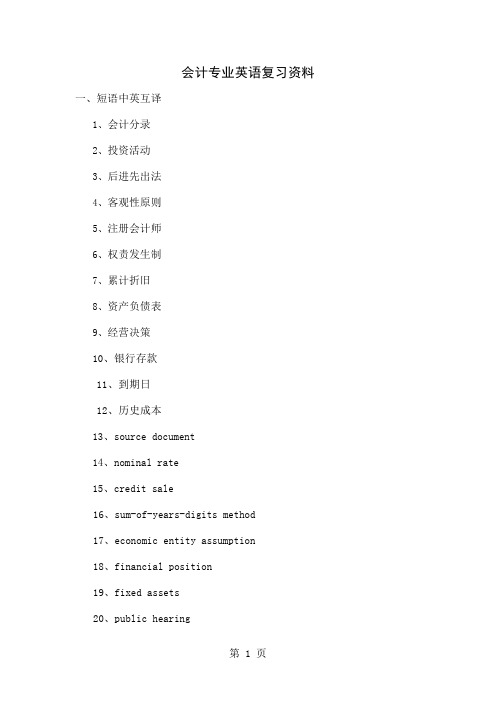
会计专业英语复习资料一、短语中英互译1、会计分录2、投资活动3、后进先出法4、客观性原则5、注册会计师6、权责发生制7、累计折旧8、资产负债表9、经营决策10、银行存款11、到期日12、历史成本13、source document14、nominal rate15、credit sale16、sum-of-years-digits method17、economic entity assumption18、financial position19、fixed assets20、public hearing21、income statement22、sales discount23、value added tax24、trade mark25、bank overdraft二、从下列选项中选出最佳答案1、Generally,revenue is recorded by a business enterprise at a pointwhen :( )A、Management decides it is appropriate to do soB、The product is available for sale to consumersC、An exchange has taken place and the earning process isvirtually completeD、An order for merchandise has been received2、Why are certain costs capitalized when incurred and then depreciated or amortized over subsequent accounting periods?( )A、To reduce the income tax liabilityB、To aid management in making business decisionsC、To match the costs of production with revenue as earnedD、To adhere to the accounting concept of conservatism3、What accounting principle or concept justifies the use of accruals and deferrals?( )A、Going concernB、MaterialityC、ConsistencyD、Stable monetary unit4、An accrued expense can best be described as an amount ( )A、Paid and currently matched with revenueB、Paid and not currently matched with revenueC、Not paid and not currently matched with revenueD、Not paid and currently matched with revenue5、Continuation of a business enterprise in the absence of contrary evidence is an example of the principle or concept of ( )A、Business entityB、ConsistencyC、Going concernD、Substance over form6、In preparing a bank reconciliation,the amount of checks outstanding would be:( )A、added to the bank balance according to the bank statement.B、deducted from the bank balance according to the bank statement.C、added to the cash balance according to the depositor’s records.D、deducted from the cash balance according to the depositor’srecords.7、Journal entries based on the bank reconciliation are requiredfor:( )A、additions to the cash balance according to the depositor’srecords.B、deductions from the cash balance according to the depositor’srecords.C、Both A and BD、Neither A nor B8、A petty cash fund is :( )A、used to pay relatively small amounts。
会计专业英语学习资料

商誉goodwill 有形资产Tangible assets 处置disposal 摊销amortization固定资产Plant assets/Property plant and equipment/Fixed assets 股东Shareholder直线法Straight-line method 双倍余额递减法Double-declining-balance method年数总和法Sum-of-the-years’-digits method房地产中介Real estate broker定率递减余额法fixed-percentage-of-declining-balance method付款服务费用Escrow fee累计折旧Accumulated depreciation资产净值Book value/Carrying amount减值Impairment资本化Capitalize会计主体假设Business entity assumption公认会计准则GAAP(general accepted accounting principal)会计分期假设Time period assumption国际会计准则委员会IASB(international accounting standard board) 透支Bank overdraft国际会计准则IFRS(international financial reporting standard)持续经营假设Going concern assumption 内部审计Internal auditor货币计量假设Monetary unit assumption 历史成本原则Cost principal存deposit 取Withdrowal 收入确认原则Revenue recognition principle 配比原则Matching principal 汇率Exchange rate全面披露原则Full disclosure principal 会计恒等式accounting equation 背书Endorsement现金收据Cash receipt现金支出Cash disbursement 现金余额Cash balance筹资活动Financial activities经营活动Operating activities投资活动Investing activities应纳税所得Taxable income一般管理经费overhead 本金额Principal amount现值Present value股利、红利dividend 留存收益Retained earning 合同contract审计报告Audit report/auditor’s report佣金commission 支票本Checkbook 支票存根Check stubs 借/贷通知单Debit/Credit memorandom银行记账单Bank statement应收票据Notes receivable 经营周期Operating cycle直接核销法Direct write off method 备抵法Allowance method坏账准备Allowance for Doubtful Accounts 销售百分比法Percentage of sale应收账款百分比法Percentage of receivable 账龄分析法Aging of the accounts receivable到期日Maturity date(due day) 加权平均Weighted average (average cost)先进先出First-in, first-out(FIFO)后进先出Last-in, first-out(LIFO)可识别无形资产Identifiable intangible assets:Indentifiable intangible assets are those intangibles that can be purchased or sold separately from the other assets of the company.折旧Depreciation is the systematic allocation of the depreciable amount of an asset over its useful life.可实现净值Net realisable value is the estimated selling price in the ordinary course of business less the estimated costs of completion and the estimated costs necessary to make the sale.权责发生制Accrual basis accounting:An accounting method that records financial events based on economic activity rather financial activity. Under accrual accounting revenue is recorded when it is earnd and realized, regardless of when actual payment is received.会计Accounting may be described as the process of identifying, measuring, recording, and communicating economic information to permit informed judgments and decisions by users of that information.An asset is a resource controlled by the enterprise as a result of past events and from which future economic benefits are expected to flow to the enterprise.现金cash:Accountants define cash as money on deposit in banks and any items that a bank will accept for deposit.企业已付银行未付Outstanding checks:Checks issued and recorded by the company but not yet presented to the bank for payment.应收账款Accounts receivable:Accounts receivable are liquid assets, usually being converted into cash within a period of 30 to 60 days.收入Revenue:Revenue is the gross inflow of economic benefits during the period arising in the course of the ordinary activities of an entity when those inflows result in increase in equity, other than increases relating to contributions from equity participants.收益应按照实收款项和应收款项的公允价值计算.Revenue shall be measured at the fair value of the consideration received or receivable.交易中所产生的收益一般是按照会计主体和资产购买或使用双方的协议决定的.The amount of revenue arising on a transaction is usually determined by agreement between the entity and the buyer or user of the asset.存货应该按照”成本”和”可实现净值”底的计算Inventories shall be measured at the lower of cost and net realisable value.存货包括那些买入是以卖出为目地的物品. 比如, 零售商买入机器设备是为再销售, 或者那些为了出售而买入的土地和其他的房产.Inventories encompass goods purchased and held for resale including, for example, merchandise purchased by retailer and held for resale, or land and other property held for resale.存货成本应该包括所有购买的费用, 生产的费用和其他那些发生在使存货转移到目前地点和状态的费用.the cost of inventories shall comprise all costs of purchase, costs of conversion and other costs incurred in bringing the inventories to their present location and condition.资产净值:Carrying amount is the amount at which an asset is recognised after deducting any accumulated depreciation and accumulated impairment losses.折旧:Depreciation is the systematic allocation of the depreciable amount of an asset over its useful life.残值:The residual value is the estimated amount that an entity would currently obtain from disposal of the asset, after deducting the estimated costs of disposal, if the asset were already of the age and in the condition expected at the end of its useful life.Amortisation is the systematic allocation of the depreciable amountof an intangible asset over its useful life.开发:开发是指在进行商业性的生产或使用前,将研究成果或其他知识应用于某项计划或设计,以生产出新的或具有实质性改进的材料,装置,产品,工艺,系统或服务。
专业会计英语知识点

专业会计英语知识点会计是一门应用广泛且非常重要的学科,其它行业也需要掌握一些会计知识。
而对于会计专业的学生来说,掌握专业会计英语知识是非常重要的。
本文将从几个方面介绍一些专业会计英语知识点,帮助读者扩展词汇量并加深对会计专业的理解。
一、会计概述1. 资产(Assets):指企业拥有的可以转化为现金或其他货币等额物品或资源。
2. 负债(Liabilities):指企业当前无法避免的经济付出或责任。
3. 所有者权益(Equity):指企业所有者在资产减去负债后拥有的部分。
4. 利润(Profit):指企业在特定期间内实现的净收入。
5. 财务报表(Financial Statements):指记录和报告企业财务状况和经营成果的文书。
二、会计核算1. 应收账款(Accounts Receivable):指企业因向顾客提供商品或服务而发生的未收回款项。
2. 应付账款(Accounts Payable):指企业因购买商品或服务而产生的未偿付款项。
3. 现金流量表(Cash Flow Statement):指反映企业现金流入和流出的报表。
4. 会计准则(Accounting Standards):指制定和规范会计工作的基本原则和规则。
5. 成本核算(Cost Accounting):指对企业产品或服务成本的计算和分析。
三、财务报告1. 利润表(Income Statement):指反映企业一定期间内收入、成本和利润等信息的报表。
2. 资产负债表(Balance Sheet):指反映企业在某一特定日期上的资产、负债和所有者权益等信息的报表。
3. 现金流量表(Cash Flow Statement):指企业一定期间内现金流入和流出的报表。
4. 股东权益变动表(Statement of Changes in Equity):指记录了企业一定期间内股东权益变动的报表。
5. 会计政策(Accounting Policies):指企业在编制财务报表过程中选择的评估方法和会计处理原则。
会计英语培训资料
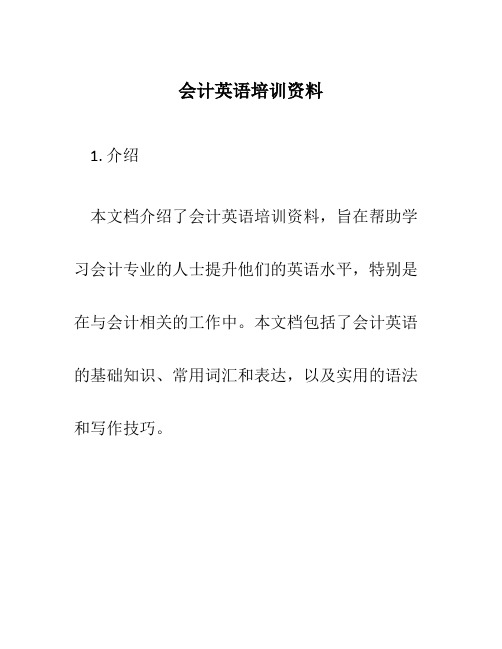
会计英语培训资料1. 介绍本文档介绍了会计英语培训资料,旨在帮助学习会计专业的人士提升他们的英语水平,特别是在与会计相关的工作中。
本文档包括了会计英语的基础知识、常用词汇和表达,以及实用的语法和写作技巧。
2. 会计英语基础知识2.1 会计专业术语在学习会计英语之前,了解一些基本的会计专业术语是很重要的。
以下是一些常见的会计术语的英文翻译:•资产 (Assets)•负债 (Liabilities)•所有者权益 (Equity)•收入 (Income)•成本 (Cost)•利润 (Profit)•现金流量 (Cash flow)•财务报表 (Financial statements)2.2 会计原则会计原则是会计工作的基础,理解和掌握这些原则对于正确运用会计英语至关重要。
以下是一些常见的会计原则及其英文表达:•全盘概念 (Going concern concept)•会计主体 (Accounting entity)•会计周期 (Accounting period)•公允价值 (Fr value)•成本原则 (Cost principle)•可比性 (Comparability)•重要性 (Materiality)•一致性 (Consistency)3. 会计英语常用词汇和表达3.1 会计报表相关词汇在与会计报表相关的工作中,掌握以下词汇和表达将有助于准确理解和使用会计英语:•资产负债表 (Balance sheet)•损益表 (Income statement)•现金流量表 (Cash flow statement) •经营活动现金流量 (Operating activities cash flow)•投资活动现金流量 (Investing activities cash flow)•筹资活动现金流量 (Financing activities cash flow)•净利润 (Net income)•总资产 (Total assets)3.2 会计审计相关词汇会计审计是会计工作中的重要环节,以下是一些与会计审计相关的词汇和表达:•外部审计 (External audit)•内部审计 (Internal audit)•审计师 (Auditor)•会计准则 (Accounting standards)•审计报告 (Audit report)•无保留意见 (Unqualified opinion)•保留意见 (Qualified opinion)•强调事项 (Emphasis of matter)4. 会计英语语法和写作技巧4.1 语法规则掌握一些基本的会计英语语法规则是提高语言表达能力的重要一步。
会计有关英文知识点

会计有关英文知识点会计是一门重要的商科学科,负责记录、处理和报告财务信息。
在全球化的背景下,掌握与会计相关的英文知识点对于从事会计工作的人员来说至关重要。
本文将介绍一些与会计有关的英文知识点,帮助读者扩展自己的会计英语词汇量,提高在国际商务领域的竞争力。
1. Financial Statements(财务报表)财务报表是记录一个企业财务状况和业绩的重要文件。
主要的财务报表包括资产负债表(Balance Sheet)、利润表(Income Statement)、现金流量表(Cash Flow Statement)和所有者权益变动表(Statement of Changes in Equity)。
掌握这些财务报表的英文术语,例如Assets(资产)、Liabilities(负债)、Revenue(收入)和Expenses(费用),对于理解和分析财务报表至关重要。
2. Accounting Principles(会计准则)会计准则是会计行业遵循的规范和原则,它确保了财务信息的准确性和可比性。
全球范围内最常用的会计准则是国际财务报告准则(International Financial Reporting Standards,简称IFRS)。
例如,IFRS中对于Revenue Recognition(收入确认)和Inventory Valuation(存货估值)都有明确的规定。
了解这些会计准则的英文表达,有助于与国际企业或者国际会计师进行有效的沟通。
3. Audit(审计)审计是对财务报表进行独立、客观的评估和核实,以确定其真实性和合规性。
在全球商业环境中,英文中经常使用的审计术语包括External Audit(外部审计)和Internal Audit(内部审计)。
掌握这些术语以及与审计相关的表达,例如Auditor(审计师)和Audit Report(审计报告),是面对国际审计事务的必备技能。
4. Taxation(税务)税务是会计领域中一个重要的方面,涉及到企业和个人的纳税义务。
会计专业英语复习资料

会计专业英语复习资料Post test 1 基本概念1. Things of value owned by an entity: assetsMoney: cashClaims of creditors: liabilitiesClaims of investors: equity2. 2 types of sources of funds:Stronger claim: liabilitiesLesser claim: equity3. A balance sheet reports the status of an entity ....at a point of time.4. Give the fundamental accounting equation: Assets = Liabilities + Equity5. The above equation is consistent with what concept?: Dual-aspect concept6. Money-measurement concept states that accounting reports only facts that can be expressed in monetary amounts.7. A balance sheet does not report all the facts about a business. What concept limits the amount or type of information that can be reported? Money-measurement concept8. Brown Company has 10000 dollar cash. Its owner withdraws 100 dollars for his own use. The owner is (no better or worse off) than he was before. Brown company now has (less) cash. The fact that this event affects the owner differently than it affects the company is an illustration of the entity concept.9. The entity concept states that accounts are kept for entities as distinguished from the persons who own those entities.11. The going-concern concept is: Accounting assumes that an entity will continue to operate indefinitely.12. The asset-measurement concept is: if reliable information is available, accounting focuses on the fair value of assets. Nonmonetary assets are reported at their original cost.13. An item can be reported as an asset if it passes 3 of the following: item is valuable, item was acquired at a measurable cost, item is owned or controlled by the entity.14. Goodwill is a favorable name or reputation purchased by the entity.15. An asset is classified as current if it is cash or is expected to be converted into cash in the near future, usually within one year.16. A liability is classified as current if it becomes due in the near future, usually within one year.17. Marketable securities are current assets. Investments are noncurrent assets.19. An insurance policy paid in advance of the time period covered is an example of a prepaid expense.20. A building, an item of equipment, and an automobile may all be examples of plant and property.21.Parker Company operates a furniture store. On December 31,2005,it had 30 desks that it was holding for sale. These would be reported as inventory. The desk that is used by the president of Parker Company would be reported as plant and property.22.Fox Company sold $1,000 of goods on credit to Golden Company. This would be recorded as an account receivable of Fox Company and as an account payable of Golden Company.23. Indicate whether the following statements about the balance sheet of a corporation are true or false:a. Assets list all the valuable things owned by the entity----Fb. The amount reported for the paid-in capital item isapproximately the fair value of the stock-----Fc. The amount reported for total equity is approximately the fair value of the corporation’s stock---Fd. Total equities (also called “net worth”) show approximately what the entity is worth.----Fe. Retained earnings is the amount of cash retained in the entity.-----FPost test 2 资产负债表的变更:收入的核算1.On January 2, John Brown started the Brown Company. In January, Brown Company did the following things:a. It received $5,000 cash from John Brown as its capital.b. It borrowed $10,000 from a bank, giving a note therefor.c. It purchased $4,000 of inventory for cash.d. It sold $2,000 of its inventory for $6,000 to a customer, who paid $3,500 cash and agreed to pay $2,500 within 30 days.e. It purchased an auto for $7,000. It paid $2,000 down and gave a note to the automobile dealer for the remaining $5,000f. Brown withdrew $1,000 cash for his personal use.g. Brown was offered $10,000 for his equity in the business, but he refused the offer.On a separate piece of paper, prepare a rough draft of a balance sheet for Brown Company as of the close to business January 31, and an income statement for January.Brown CompanyBalance Sheet as of Jan31AssetsCash……………………………………$11,500Accounts Receivable…………………2,500 Inventory………………………………….2,000 Automobile………………………………7,000Total………………………………………$23,000Liabilities and EquityNotes Payable………………………$15,000Paid-in Capital…………………………5,000Retained Earnings……………………3,000 Total……………………………………$23,000Brown CompanyIncome Statement for January Revenue...........................$6,000 Expense ...........................$2,000Income ............................$4,0002.Brown Company's income was $4,000, but its Retained Earnings was only $3,000. Reread the first frame and choose the item (a-g) that explains the difference. f3.John Brown claims that the inventory as of January 31 is worth $6,000, as shown by the fact that inventory costing $2,000 was actually sold for $6,000. Would you change the balance sheet ?...(No). This is an illustration of the asset-measurement concept. Nonmonetary assets are reported at their cost rather than their worth or fair value.Post test 3 会计记录和系统1. On March 5, Kay Company purchased $6,000 of inventory, paying cash.Prepare a journal entry for this transaction below.Journal2001 Transactions Dr. Cr.March 5Inventory6,000Cash6,0002. On March 10, Kay Company made a $15,000 sale to a customer who paid $6,000 cash and agreed to pay to the other $9,000 in 30 days. The merchandise sold had cost $8,000. Preparea journal entry for the sale, below.Journal2001 Transactions Dr. Cr.March 10Cash6,000Accounts Receivable9,000Revenues15,0003. On March 10, Kay Company made a sale for $15,000 for merchandise that had cost $8,000. Prepare a journal entry to record the cost of the sale below.Journal2001 Transactions Dr. Cr.March 10 Expenses8,000Inventory8,0004. Recall from the previous frames that revenues from the sale on March 10 were $15,000 and that the merchandise sold had cost $8,000. Prepare the closing entries.Journal2005 Transactions Dr. Cr.March 31Revenues15,000Retained earnings15,000March 31Retained earnings8,000Expenses8,0005-10. Omit11. A critic said that the company had $25,000 cash at the beginning ofMarch and $25,000 at the end of March, and since its cash balance was unchanged, it couldn't be said to have any income in March. This criticism is (incorrect).12. The reason the criticism is incorrect is because income is an increase inretained earnings, not necessarily in cash. For example, the sales revenue of Kay Company in March was $15,000 and its income was $7,000 even though $9,000 was received in cash.Post test 4 营业收入和货币资产1. The conservation concept states that increases in equity are recognized only when they are reasonably certain, while decreases in equity are recognized as soon as they are reasonably possible.2. The materiality concept states: disregard trivial matters but disclose all important matters.3. What is the length of the usual accounting period? One year. Financial statements prepared for shorter periods are called interim statements.4. Cash accounting reports items that increase or decrease cash. Accrual accounting reports items that change equity or retained earnings, even though these changes may not affect cash.5. Increases in equity associated with the entity’s operations during a periodare revenues, and decreases are expenses. The difference between them is labeled income.6. The realization concept states that revenues are recognized when goods or services are delivered.7. H Company manufactures a table in August and places it in its retail store in September. R Smith, a customer, agrees to buy the table in October, it is delivered to him in November, and he pays the bill in December. In what month is the revenue is recognized? (November)8. The receipt of cash is a debit to Cash. What is the offsetting credit and (type of account) for the following types of salestransactions?Account Crediteda. Cash received prior to delivery. Advances from customers(a liability)b. Cash received in same period as delivery. Revenuec. Cash received after the period of delivery. Accounts receivable (an asset)9. Similarly, revenue is a credit entry. What is the offsetting debit whenrevenue is recognized in each of these periods?Account Debiteda. Revenue recognized prior to receipt of cash. Accounts receivableb. Revenue recognized in same period as receipt of cash. Cashc. Revenue recognized in the period following receipt of cash. Advances from customers10. In February, H Company agrees to sell a table to a customer for $600,and the customer makes a down payment of $100 at that time. The cost of the table is $400. The table is delivered to the customer in March, and the customer pays the remaining $500 in April. Give the journal entries (if any) that would be made in February, March, and April for both the revenue and expense aspects of this transaction. February:Cash100Advances from customers100March:Accounts receivable500Advances from customers100Revenue600March:Expenses400Inventory400April:Cash500Accounts receivable50011. At the end of 2005, M Company had accounts receivable of $200,000,and it estimated that $2,000 of this amount was a bad debt. Its revenue in 2005, with no allowance for the bad debts, was $600,000.A. What account should be debited for the $2,000 bad debt? RevenueB. What account should be credited? Allowance for doubtful accountsC. What amount would be reported as net accounts receivable on the balance sheet? $198,000D. What amount would be reported as revenue on the 2005 income statement? $598,00012. In 2006, the $2,000 of bad debt was written off.A. What account should be debited for this written off? Allowance for doubtful accountsB. What account should be credited? Accounts receivablePost test 5 费用的核算;损益表1. An expenditure occurs in the period in which goods or services are acquired. An expense occurs in the period in which goods or services are consumed.2. A certain asset was acquired in May. There was therefore an expenditure in May. At the end of May, the item was either onhand, or it was not. If it was on hand, it was an asset; If it was not on hand, it was an expense in May.3. Productive assets are unexpired costs. Expenses are expired costs.4. The matching concept states that costs associated with the revenues of a period are expenses of that period.5. Expenses of a period consist of:a. costs of the goods and services delivered during that period.b. other expenditures that benefit operations of the period.c. losses6. If Brown company pays rent prior to the period that the rent covers, the amount is initially reported as credit to cash and a debit to Prepaid Rent, which is an asset account. If Brown Company pays the rent after the period covered, the amount is initially recorded as a debit to Rent Expense and a credit to Accrued Rent, which is a liability account.7. A brand new machine owned by Fay Company was destroyed by fire in 2005. It was uninsured. It has been purchased for $10,000 with the expectation that it would be useful for 5 years. The expense recorded in 2005 should be $10,000.8. Gross margin is the difference between sales revenue and cost of sales.9. gross margin percentage: (gross margin)/(sales revenue)10. The difference between revenues and expenses in an accounting period (or the amount by which equity [i.e., retained earnings] increased from operating activities during the period) is called net income.11. A distribution of earnings to shareholders is called dividends(股利).12. retained earnings at the end of the period= retained earnings at the beginning of the period + net income – dividends.Post test 6 存货和销售成本1. A dealer sells a television set for $800 cash. It had cost $600. Write journal entries for the four accounts affected by this transaction.Dr. Cash800Cr. Revenue800Dr. Cost of Sales600Cr. Inventory6002. When using the perpetual inventory method (永续盘存), a record is kept for each item, showing receipts, issues, and the amount on hand.3. Write an equation that shows how the cost of sales is determined by deduction:Cost of sales = beginning inventory + purchases – ending inventory4. Omit5. In periods of inflation, many companies use the LIFO method incalculating their taxable income because LIFO gives a higher cost of sales and hence a lower taxable income.6. A company discovers that the fair value of its inventory is $1000 lower than its cost. What journal entry should it take?Dr. Cost of Sales1,000Cr. Inventory1,0007. In a manufacturing business, what three elements enter into the cost of a manufactured item?Direct material, direct labor, and overhead.8. Period costs become an expense during the period inwhich they were incurred.9. Product costs become an expense during the period in which the products were sold.10. One type of overhead rate involves use of the total direct labor costs and total production overhead costs for a period. Write a ratio that shows how the overhead rate is calculated.(Total production overhead costs)/(Total direct labor costs)11. A given finished item requires $50 of direct materials and 5 hours of direct labor at $8 per hour. The overhead rate is $4 per direct labor hour. At what amount would the finished item be shown in inventory? $110= 50+ 40 + 2012. An inventory turnover of 5 is generally better than an inventory turnover of 4 because it indicates that less capital is tied up in inventory, and there is less risk that the inventory will become obsolete.Post test 7 非流动资产和折旧1. The amount at which a new plant asset is recorded in the accounts includes its purchase price plus all costs incurred to make the asset ready for its intended use (such as transportation and installation).2. A plant asset is acquired in 2005. It is expected to be worn out at the end of 10 years and to become obsolete in five years. What is its service life? ---Five years.3. Ordinarily, land is not depreciated because its service life is indefinitely long.4.A plant asset is acquired in 2005 at a cost of $20000. Its estimated service life is 10 years, and its estimated residual value is $2000 :a. The estimated depreciable cost of the asset is $18,000b. If the straight-line depreciation method is used, thedepreciation rate for this asset is 10 percent.c. What amount will be recorded as depreciation expense in each year of the asset’s life?---$1,800d. What amount will be debited and what account will be credited to record this depreciation expense?Dr. Depreciation expenseCr. Accumulated depreciatione. After five years have elapsed, how would this asset be reported on the balance sheet?1) Plant------$20,0002) Less accumulated depreciation-------$9,0003) Book value-------$11,0005. A machine is purchase on January 2, 2005, for $20,000 and its has an expected life of five years and no estimated residual value.a. If the a machine is still in use six years later, what amount of depreciation expense will be reported in for the sixth year?----zerob. What amount, if any, will be reported on the balance sheet at the end of the sixth year?1) It will not be reported.-----X2) It will be reported as follows:Machine $20,000Accumulated depreciation $20,000Book value $06. A machine is purchase on January 2, 2005, for $50,000. It has an expected service life for 10 years and no residual value. Eleven years later it is sold for $3,000 cash.a. There will be a gain of $3,000b. What account will be debited and what account creditedto record this amount?Dr. CashCr. Gain on disposition of assets.7. Given an example of each of the following types of assets, and give the name of the process used in writing off the cost of the second and third type.Asset type\Example\Write-off processPlant Asset\m achine, b uilding\DepreciationWasting asset\c oal, o il ,m inerals\DepletionIntangible asset\g oodwill, t rademark \Amortization8. Conoil Company purchased a producing oil property for $10,000,000 on January 2, 2005. It estimated that the property contained one million barrels of oil and that the property had a service life of 20 years. In 2005, 40,000 barrels of oil were recovered from the property. What amount should be charged as an expense in 2005?------$400,0009. Wasting assets and intangible assets are reported on the balance sheet ina different way than building, equipment, and similar plant assets. The difference is that wasting assets are reported at the net amount and plant assets are reported at cost, accumulated depreciation, and net amount. 10. In calculating its taxable income, a company tries to report its income as low as it can. In calculating its financial accounting income, a company tries to report its income as fairly as it can.11. As compared with straight-line depreciation, accelerated depreciation writes off more depreciation in the early years of an asset’s life and less in the later years. Over the whole life of asset, accelerated depreciation writes off the same total cost as straight-line depreciation.12. Companies usually use accelerated depreciation in tax accounting because it reduces taxable income and hence income tax in the early years.13. Assume an income tax rate of 40%. If a company calculated its financial accounting income (before income taxes) in 2005 as $6 million and its taxable income as$4 million, what amount would it report as income tax expense on its 2005 income statement?----$2,400,00014. Fill in the missing name on the following table:Income tax expense $100,000Income tax paid -60,000Deferred income tax $ 40,000The $40,000 would be reported on the balance sheet as a liability.。
会计专业英语知识点汇总

会计专业英语知识点汇总会计专业是现代商业领域中非常重要的一门专业。
在学习会计专业时,除了掌握会计理论和实践技巧外,掌握一定的英语知识也是非常重要的。
本文将为大家汇总一些会计专业的英语知识点,希望能够帮助到学习会计专业的同学们。
1.会计基础知识 (Accounting Basics)–Assets:资产–Liabilities:负债–Equity:所有者权益–Revenue:收入–Expenses:费用–Balance Sheet:资产负债表–Income Statement:损益表–Cash Flow Statement:现金流量表2.会计准则和规范 (Accounting Standards and Regulations)–Generally Accepted Accounting Principles (GAAP):通用会计准则–International Financial Reporting Standards (IFRS):国际财务报告准则–Financial Accounting Standards Board (FASB):美国财务会计准则委员会–International Accounting Standards Board (IASB):国际会计准则委员会3.资产负债表相关术语 (Balance Sheet Terminology)–Current Assets:流动资产–Non-current Assets:非流动资产–Current Liabilities:流动负债–Non-current Liabilities:非流动负债–Shareholders’ Equity:股东权益–Goodwill:商誉–Depreciation:折旧–Amortization:摊销4.损益表相关术语 (Income Statement Terminology)–Gross Profit:毛利润–Operating Income:营业收入–Operating Expenses:营业费用–Net Income:净收入–Earnings per Share (EPS):每股收益5.现金流量表相关术语 (Cash Flow Statement Terminology)–Cash Inflows:现金流入–Cash Outflows:现金流出–Operating Activities:经营活动–Investing Activities:投资活动–Financing Activities:筹资活动–Net Cash Flow:净现金流量6.会计报表分析 (Financial Statement Analysis)–Ratio Analysis:比率分析–Liquidity Ratios:流动性比率–Solvency Ratios:偿债能力比率–Profitability Ratios:盈利能力比率–Efficiency Ratios:效率比率7.审计和内部控制 (Auditing and Internal Control)–Audit:审计–Internal Control:内部控制–Segregation of Duties:职责分离–Internal Audit:内部审计–External Audit:外部审计8.税务会计 (Tax Accounting)–Taxable Income:应税收入–Tax Deductions:税收减免–Tax Credits:税收抵免–Tax Liability:税务负债–Tax Planning:税务规划这些是会计专业中一些重要的英语知识点,希望能够帮助到学习会计专业的同学们。
- 1、下载文档前请自行甄别文档内容的完整性,平台不提供额外的编辑、内容补充、找答案等附加服务。
- 2、"仅部分预览"的文档,不可在线预览部分如存在完整性等问题,可反馈申请退款(可完整预览的文档不适用该条件!)。
- 3、如文档侵犯您的权益,请联系客服反馈,我们会尽快为您处理(人工客服工作时间:9:00-18:30)。
Unit 1Financial information about a business is needed by many outsiders .These outsiders include owners, bankers, other creditors, potential investors, labor unions, government agencies ,and the public ,because all these groups have supplied money to the business or have some other interest in the business that will be served by information about its financial position and operating results. 许多企业外部的人士需要有关企业的财务信息,这些外部人员包括所有者、银行家、其他债权人、潜在投资者、工会、政府机构和公众,因为这些群体对企业投入了资金,或享有某些利益,所以必须得到企业财务状况和经营成果信息。
Unit 2Each proprietorship, partnership, and corporation is a separate entity.每一独资企业、合伙企业和股份公司都是一个单独的主体。
In accrual accounting, the impact of events on assets and equities is recognized on the accounting records in the time periods when services are rendered or utilized instead of when cash is received or disbursed. That is revenue is recognized as it is earned, and expenses are recognized as they are incurred –not when cash changes hands .if the cash basis accounting were used instead of the accrual basis, revenue and expense recognition would depend solely on the timing of various cash receipts and disbursements.Unit 3During each accounting year ,a sequence of accounting procedures called the accounting cycle is completed.在每一会计年度内,要依次完成被称为会计循环的会计程序。
Transactions are analyzed on the basis of the business documents known as source documents and are recorded in either the general journal or the special journal, i. e . the sales journal ,the purchases journal (invoice register ) ,cash receipts journal and cash disbursements journal .根据业务凭证即原始凭证分析各项交易,并记入普通日记账或特种日记账,也就是销货日记账,购货日记账(发票登记簿),现金收入日记账和现金支出日记账。
A trial balance is prepared from the account balance in the ledger to prove the equality of debits and credits.根据分类账户的余额编制试算平衡表,借以验证借项和贷项是否相等。
A T-account has a left-hand side and a right-hand side, called respectively the debit side and credit side.一个T 型账户有左方和右方,分别称做借方和贷方。
After transactions are entered ,account balance (the difference between the sum of its debits and the sum of its credits ) can be computed.当各项交易入账之后,便可计算账户余额(其借项合计数与贷项合计数之间的差额)The process of transferring amounts entered in the journal to the proper ledger amounts is called posting, the objective of which is to classify the effects of transactions on each individual asset , liability , owners’ equity , revenue , and expense account .将日记账记录的金额转入恰当的分类账户的过程叫做过账。
其目的在于把每笔交易对资产、负债、业主权益、收入和费用的个别账户的影响进行归类。
Unit 4The basic principle of double-entry bookkeeping is that every transaction has a twofold effect .复式记账的基本原理是每一项交易活动都有双重的结果。
The financial condition or position of a business enterprise is represented by the relationship of assets to liabilities and capital.一个企业的财务状况是由资产对负债和资本的关系来表示的。
By convention, asset and expense increases are recorded as debits while liability , capital and income increases are recorded as credits.根据惯例,资产和费用的增加被记为借项,而负债,资本和收入增加被记为贷项。
Unit 5The simplest form of the account is known as the T-account because it resembles the letter T. the accountant, as a matter of convenience, refers to the group of company account as the ledger.账户最简单的形式称为丁字账户,因为它类似大写字母T。
会计人员为了方便将公司账户集中作为分类账。
Unit 6The financial statements are the means of conveying to management and to interested outsiders a concise picture of the profitability and financial position of the business. These are three basic financial statements which are reported the financial position of a business: balance sheet, income statement, the statement of cash flows. Balance sheet and income statement are prepared at a particular data, customarily to prepare them at the end of each month .财务报表是向管理人员和有关外界人士传送企业盈利能力和财务状况的简明情况的工具。
报告一个企业财务状况的有三种基本财务报表:资产负债表,损益表和现金流量表。
资产负债表和损益表是在特定日期编制的,习惯上在每个月末编制。
Assets are economic resources which are owned by a business and are expected to benefit future operations.资产是一个企业所拥有的、并期望有益于未来经营的经营资源。
The owners’ equity in a business represents the resources the invested by the owner; it is equal to the total assets minus the liabilities. The equity of the owner is a residual claim because the claims of the creditors legally come first. If you are the owner of a business, you are entitled to whatever remains after the claims of the creditors are fully satisfied.企业中的业主权益代表业主投资的资源;它等于总资产减去负债。
因为债权人的求偿权在法律上优先,所以业主权益是一种剩余求偿权,如果你是企业的业主,在债权人的求偿权全部得到满足之后,剩下的都属于你。
Unit 7Income statement is a statement, sometimes called the profit and loss statement, reporting profitability or the operating result of a business for an accounting period (which can be one month, one quarter, one calendar year or one fiscal year as may be determined by the business concerned).收益表,有时也叫做收益损失表,是用来报告企业一定会计期间(可以是一个月、一季度、一自然年度或一财政年度,由企业自己决定)的盈利情况或经营成果的报表。
